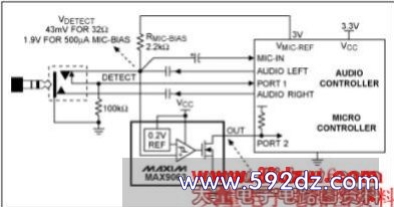Keep Power Consumption in Chec
[05-04 22:12:52] 来源:http://www.592dz.com 模拟电子技术 阅读:9997次
概要:rnal power source. They do, however, require a few volts to power an internal preamplifier FET.Figure 3. An electrical model of an electret microphone.The electret microphone appears as a constant-current sink that provides very high output impedance. Its high impedance is then converted by the FET preamplifier to the low impedance necessary for interfacing with the subsequent amplifier. Thus, the electret microphone's low cost, small size, and good sensitivity make it a good choice for applications like hands-free cell-phone headsets and c
Keep Power Consumption in Chec,http://www.592dz.com
Figure 2. A three-conductor audio jack.
Electret Microphones
A typical electret microphone (Figure 3) has a condenser element whose capacitance varies in response to mechanical vibrations, thereby providing voltage variations proportional to the sound waves. Electret microphones have a permanent, built-in static charge and, therefore, require no external power source. They do, however, require a few volts to power an internal preamplifier FET.
Figure 3. An electrical model of an electret microphone.
The electret microphone appears as a constant-current sink that provides very high output impedance. Its high impedance is then converted by the FET preamplifier to the low impedance necessary for interfacing with the subsequent amplifier. Thus, the electret microphone's low cost, small size, and good sensitivity make it a good choice for applications like hands-free cell-phone headsets and computer sound cards.
The microphone is biased through a resistor (usually 1kΩ to 10kΩ) and a supply voltage that provides the necessary constant-bias current. This bias current ranges from 100µA to about 800µA, depending on the particular microphone and its manufacturer. The bias resistor is selected according to the applied supply voltage, the desired bias current, and the required sensitivity. Based on these factors, the necessary bias voltage varies from part to part and with operating conditions. A 2.2kΩ load resistor with 3V supply drawing 100µA, for example, develops a bias voltage of 2.78V. A similar resistor drawing 800µA under similar conditions develops a bias voltage of 1.24V.
To detect the type of headset connected, refer to Figure 4. Here a 2.2kΩ RMIC-BIAS resistor connects to a low-noise reference voltage from the audio controller (VMIC-REF). When an audio jack is inserted, this VMIC-REF voltage is applied through RMIC-BIAS to the tip-to-ground resistance (not shown), thus producing the voltage VDETECT at the noninverting input of the . This resistance can be small for stereo headphones (8Ω, 16Ω, or 32Ω), or high due to the microphone's constant-current sink which ranges from 100µA to about 800µA according to the type of microphone. Because VDETECT varies with the model of headset plugged in, the headset type is detected by monitoring VDETECT with a comparator.
Figure 4. A comparator circuit used for headset detection.
Assuming that the microcontroller's reference voltage (VMIC-REF) is 3V as shown, a 32Ω headphone load produces 43mV at VDETECT. A constant 500µA microphone load, however, produces 1.9V. Note that a direct interface for VDETECT can be challenging in most practical cases. Assuming that the CMOS inputs of a typical microcontroller port demand logic levels above 0.7 × VCC and below 0.3 × VCC, then the input logic for a controller operating with a 3.3V supply should be above 2.3V and below 1V.
A 1.9V level generated by a 500µA microphone load does not qualify as a valid logic 1. Microphone bias currents from 100µA to 800µA generate VDETECT levels from 2.78V to 1.24V, and any voltage below 2.3V violates the controller's VIH specification (input high level, assuming 2.2kΩ for RBIAS). To get 2.3V or above, the microphone bias current must be 318µA or less. Otherwise you must change the 2.2kΩ bias-resistor value which, in turn, changes the sensitivity point of the microphone. Generating a logic low of 1V and below is easy, because headphones with typical 32Ω loads can easily pull the level close to ground.
To detect the type of headset connected, you therefore feed VDETECT to one input of a comparator and a reference voltage to the other input. The comparator's output state then represents the type of headset.
- 最新《模拟电子技术》
- 热门《模拟电子技术》